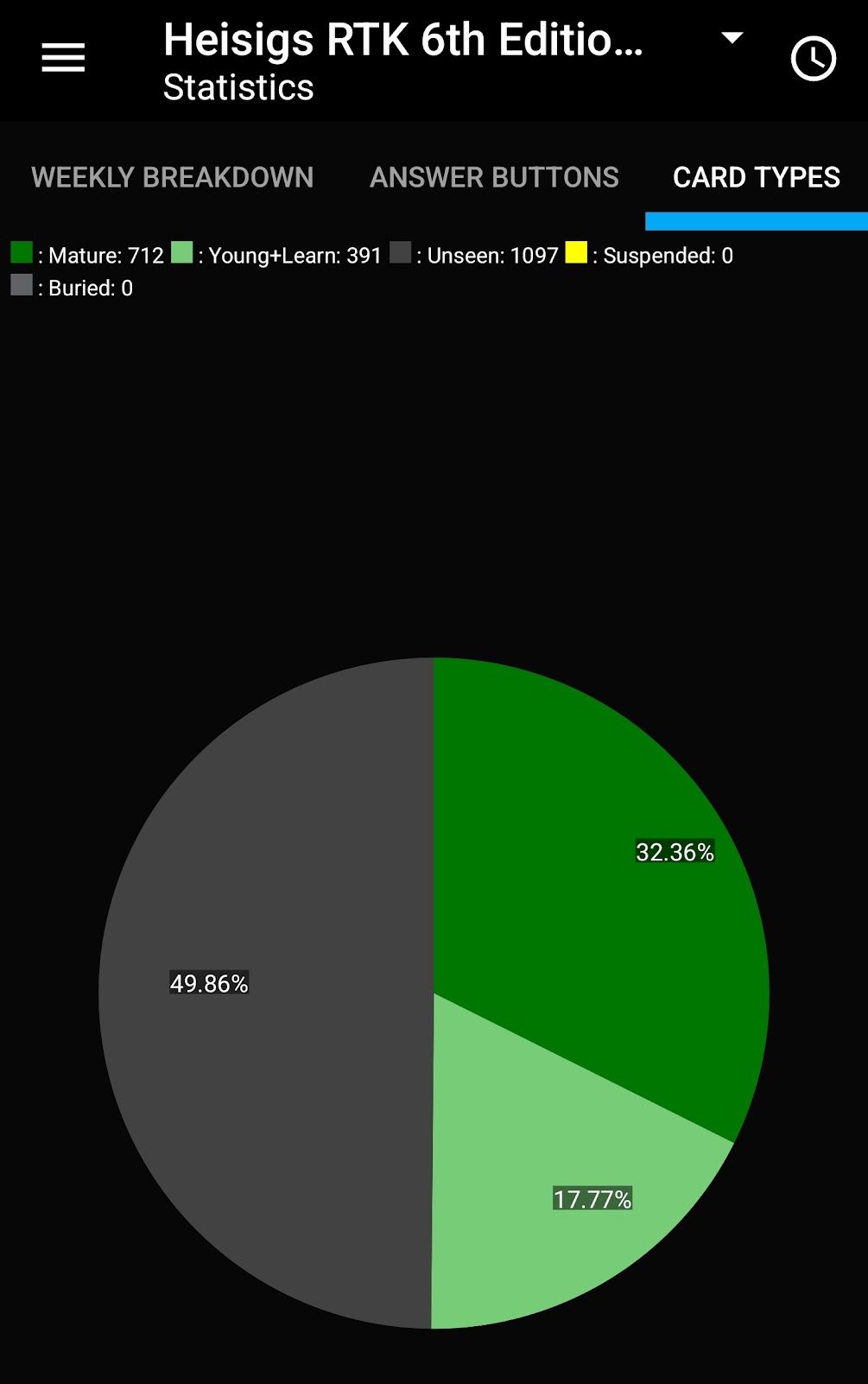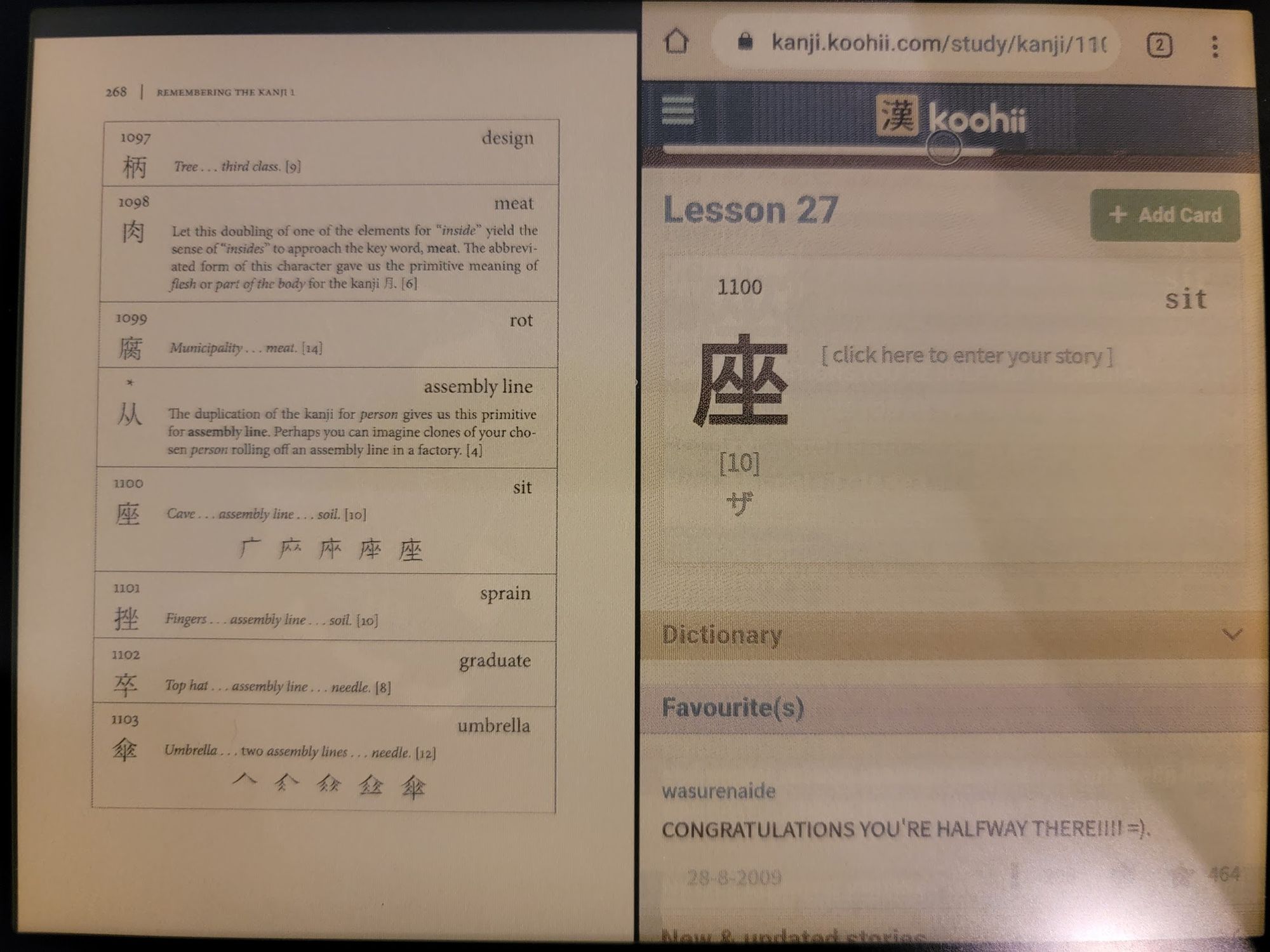Review 2: Remembering the Kanji, vol 1
On making it halfway (1,100 out of 2,200) to kanji "literacy" in 4 months with Remembering the Kanji.
Another milestone! After ~4 months, I have achieved 50% kanji "literacy" sticking with the Remembering the Kanji, vol. 1 method. I first talked about this textbook here in September 2022. "literacy" is in quotes because I still don't know all the readings of these kanji in different word combinations, but I at least know their primary meanings and how to write them.


Left: Anki deck progress. Middle: RTK vol. 1, in Lesson 27. Right: Koohi supplemental stories.
2,200 kanji are covered in RTK vol. 1. These are the most frequently used kanji in Japanese that average high schoolers know. RTK vol. 3 covers the last 800 kanji in Japanese, totaling 3,000. Though, it should be noted that there are at least 6-7,000 Chinese characters in existence used in the original kanji script of Chinese; to be literate in Chinese, you need to know about 3-4,000 characters.
At this point in my journey, I'm able to recognize the meanings and write out the characters of 1,100 of the most frequently used Japanese kanji. It's been quite a journey. 4 months doesn't seem like a long time, but it has certainly felt that way.
Difficulties
I've definitely hit slumps and difficulties. As I mentioned in my previous review, the more kanji and mnemonics you file away in your head, the more likely it is you'll run into collisions with other kanji and mnemonics. What was once easily, "Oh yeah, that's the kanji for excellent, so distinct from everything else," becomes, "Wait, excel, is that the kanji that looks like this or like that? No, wait, that's excellent. Or actually, that's accomplished." Or, "Why do I keep switching these two radical positions? Oh wait, it's because the radical positions for these are the opposite in this other kanji." (There are mnemonic examples as well.)
In addition to collisions, I think combined with me bumping my new kanji additions from 10 a day to 12, I am taking longer each day to finish my Anki reviews. Before, these reviews would be about 20 to 25 minutes long. Now they are more like 25 to 40 minutes long (depending on how concentrated I am).
Moreover, I mentioned in my previous review that I really liked that RTK provided mnemonics for me so I didn't have to make those up from scratch. Well, I had written that review close to the ~600 kanji mark, and to my dismay the author drops prewritten mnemonics at around ~700! :( The pedagogical idea is that at that point the student is supposed to be able to make up their own mnemonics. Booo.
Koohi mnemonics supplement
Thankfully, I remembered this website I came across before called Koohi that gathers user-submitted mnemonic stories and organizes them in the order of RTK. It has been a godsend. By the time I started using it, the collection was already chockful of submissions since at least the year 2009, as far as I have noticed.
Now my routine is to read both RTK and Koohi side by side, as pictured above. The RTK textbook is still useful to me because the author has some information there that is not on Koohi. I also find myself spinning up my own mnemonics from Koohi or RTK if they are not sufficient for me; I didn't think I would be so diligent about it, but I guess Heisig's pedagogy of having me ride without mnemonic training wheels (if I must) has worked!
This routine change has further increased the time I spend learning and reviewing new kanji. Combined with some other (mostly exciting) life changes, I find it harder to stick to my routine of, "morning: learn new kanji in book and site; evening: review Anki." Sometimes I just miss the whole day and then have to cram the next day, and I feel like such an irresponsible person... I had to pause my Anki new-kanji speed for at least 2 days since my last review, so I got behind.
Japan in February
But what's strengthened my motivation is this exciting plan to be in Japan for 50 days next year! Of course, planning for this trip is further distracting me from actually studying... but I just need to be more disciplined.
This trip is why I ramped up my new kanji pace from 10 a day to 12. I am aiming to have memorized all 2,200 of the ones needed for basic literacy before my trip begins. More thoughts on this trip in another post to come...
I'm actually...slow (?)
There are several posts on the Internet of folks claiming to have learned 2,200 kanji in 1-4 months.[1][2] It's been 4 months for me and I am only halfway. :( But I need to forgive myself.
First, I'm putting in more time to near-perfectly write out the kanji, whereas a lot of the faster claims are from people who vaguely recognize them and maybe can write out some of them with decent accuracy. This website claims my appraoch takes 5+ years, though I imagine my ability will be a little less 上手 because I can't get myself to believe I'm that smart to fit in 5+ years of ability in 7 months.
For the 90% percentile, between 1 and 3 months. The speed depends on the amount of kanji you memorize every day. For context, the equivalent ability (being able to write out 2200 kanji from memory) for conventional learners will generally take around 5+ years.
Second, I have a full time job with a family, house, and other responsibilities, whereas some of these other people may have more free time than me as younger students, etc.
Thankfully, there are also other stories online that align closer to my sort of timeline[3][4]. If I keep up this pace, I should be set in 7 months. 頑張っています。
Perhaps arguably I could be wasting effort trying to write out kanji near-perfectly, and other people are just more efficient and smarter than me. But as I mentioned in my previous post, I do find the activity of writing out the kanji quite fun in itself, and I also believe this practice more effectively solidifies the kanji in memory for the long term. I'm all about that LTI (long term investment).
Additional thoughts on RTK
Despite the slumps, I'm sticking with this methodology. I find it incredibly effective, accessible, and affordable.
Impact on Japanese learning overall
Spending so much time on kanji learning takes me away from other things I can focus on, such as more grammar, reading, listening, vocabulary building, speaking, etc.
I do still find some time to do all these things in small chunks throughout the week--I average about 2 hours of Japanese language focus a day, with kanji specifically taking up half that time--but I'm certainly weaker in most of these areas as a result.
However, as I wrote in my first review, I am picking up and retaining vocabulary so much more easily because I have gotten over the hurdle of just seeing kanji as random blobs; they are instead powerful context clues, anchors that cement the meaning of a new vocabulary word that much more quickly. While RTK volume 1 does not teach me kanji readings, I am naturally picking them up when engaging with more native reading material. I need to just keep diligently ingesting input along with my kanji study and other language skill pursuits.
Second, and related, naturally I'm getting a lot better at reading comprehension and guessing meaning accurately. Just yesterday I was reading some Magic the Gathering cards in Japanese, and I was able to accurately get the gist of 95% of the card descriptions without looking up anything in the dictionary! It helps that I know the game and rules, but still, I'm super proud of myself. Other reading endeavors at least at the easy NHK article, N3 manga, or children's short stories level are becoming easier as well.
I feel so empowered the more I progress and see these changes. It took so long to notice progress, but now that I'm starting to... :)
Here's to the next 1,100 kanji, and beyond!
See also my Japanese (re)learning progress series.